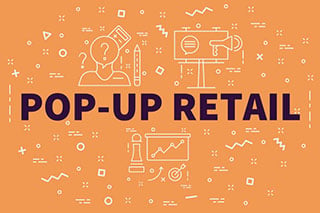
Pop-Up Shops: Your Conduit for Ecommerce Growth
Contents
Reading news of retail giants like Toys R Us, Lowe’s, Brookstone, et al, closing their doors or significantly reducing the number of stores, it has been suggested that ecommerce is the culprit. We’ve heard that, time and again.
However, according to The Store Front, “Ninety-percent of worldwide retail sales are still done in physical stores.” Kind of throws that ecommerce-killer theory out the window.
It’s simply not true. Ecommerce didn’t kill the physical stores that have been closing or reducing their footprint over the past decade.
The bigger picture is that consumers are demanding more intimate and exciting shopping experiences that big box stores alone simply couldn’t provide or didn’t realize this shift in today’s consumer buying expectations. Today, with consumers demanding a personal, vibrant and memorable experience, the key to sustainability and ecommerce growth is truly understanding who your ideal customers are and creating an aligned shopping experience that will encourage brand loyalty and future purchases.
Retailers and brands are learning (some the hard way) that the once relied upon, siloed strategy of having one or the other─digital or brick-and-mortar─ is no longer a sustainable business model. We are experiencing a reawakening in how we shop, realizing brick-and-mortar is about the physical experience, where ecommerce is about convenience and options. Employing just one of them is no longer a viable option for success. But having both is an excellent growth strategy, as the ability to cross promote is as valuable as the opportunity for you to meet your customers in person.
Not to worry, ecommerce warriors, this is great news for your business. If you’re a multichannel seller and searching for that next growth step, time to open the omnichannel door, without sinking a wad of cash into opening a brick-and-mortar store.
 Enter pop-up shops, the Snapchat of retail for multichannel sellers. They’re temporary stores and the investment is minimal, compared to opening a brick-and-mortar store. It’s more akin to preparing for a higher-end trade show than trying to open an investment-heavy brick-and-mortar.
Enter pop-up shops, the Snapchat of retail for multichannel sellers. They’re temporary stores and the investment is minimal, compared to opening a brick-and-mortar store. It’s more akin to preparing for a higher-end trade show than trying to open an investment-heavy brick-and-mortar.
Shopify identifies a pop-up shop as “a short-term, temporary retail event that is “here today, gone tomorrow.” Pop-up retail is the temporary use of physical space to create a long term, lasting impression with potential customers. A pop-up shop allows you to communicate your brand’s promise to your customers using a unique and engaging physical environment while creating an immersive shopping experience.” But Square may have said it more economically, “it keeps customers moving around within the brand ecosystem, with each channel working in harmony to nurture more sales and engagement.”
It’s not just having a pop-up shop that garners success. Today, your customers require an emotional stimulation from the pop-up experience, which is why it’s critical to understand your ideal customer and market accordingly. A memorable experience makes the best pop-up shops more valuable than a standing retail location. They build a level of customer loyalty that was once difficult to achieve without investing heavily in advertising and marketing.
Now retailers and brands must embrace both digital and brick-and-mortar as a credible marriage. Big box stores are even adding pop-up shops within their stores. Even YouTube is in the game. With 82% of smart phone users consulting their phones on purchases they are about to make in a brick-and-mortar, this marriage, or integration, makes perfect sense.
Brands use pop up shops for a variety of purposes, from creating an indelible branded experience that generates buzz and brand awareness to inexpensive testing and experimenting. Pop-ups are revolutionizing not only the way we shop; they are the face of change for all commerce today, as brands and retailers realize the significance of focusing on creating a cohesive user experience for customers at every touchpoint.
To be clear, omnichannel refers to retailers with both a physical and digital presence. And multichannel simply means selling on multiple online sales channels such as a website, marketplaces and social media. Multichannel sellers who adopt pop-up shops enter the realm of omnichannel selling.
Ten reasons to open a pop-up shop now
If you’re looking for a relatively inexpensive way to expand your sales and your brand presence, here are 10 reasons why every multichannel seller should join the ranks of omnichannel selling by giving pop-up shops a chance:
- Create a new revenue stream
- Get to know your customers—in person
- Create urgency and scarcity for faster buyer decisions
- Holiday stores are favored by consumers; revenue makers
- Educate new customers about your products
- You select where your pop-up shop location
- Create brand awareness and buzz
- Unload old inventory (the kind that’s had a birthday or two)
- Creating opportunities for your brand to experiment
- Perform cost-effective testing on new products and concepts
How to find space for your pop-up shop
The easiest way to find space is through the growing pop-up space marketplaces like:
Pop-up shops are not new: they surfaced in 2004 when the economy began to go south
Pop-ups began to appear in the depths of the financial crisis, back in 2004, when landlords were panicked as vacancy rates climbed north of 13%. To make the best of a bad situation, savvy property owners began welcoming pop-up stores to rent their unused spaces. Many were holiday-themed, local artisans or big brands test-marketing a new concept.
But something amazing happened as the economy recovered. Pop-ups, born as stop-gap measures took on a new role in the retail landscape. Shoppers grew to expect the shot of newness and creativity they brought to their daily haunts. Brands began to experiment more with pop-up shops, using the temporary nature of the stores to push the envelope of retail and marketing mixes. And newcomers to retail, such as brands and retailers, embraced the pop-up shop trend, seeing it as a new and obtainable entry into retail.
Yvette Zhou is a Group Product Manager at Webgility, passionate about SaaS, fintech, and ecommerce innovation and product development.



.png?width=56&height=56&name=image%20(3).png) Yvette Zhou
Yvette Zhou


